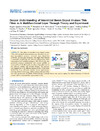Identificador persistente para citar o vincular este elemento:
https://accedacris.ulpgc.es/jspui/handle/10553/107986
| Título: | Deeper Understanding of Interstitial Boron-Doped Anatase Thin Films as A Multifunctional Layer Through Theory and Experiment | Autores/as: | Quesada Cabrera, Raúl | Clasificación UNESCO: | 2307 Química física | Fecha de publicación: | 2018 | Publicación seriada: | Journal of Physical Chemistry C | Resumen: | Thin films of interstitial boron-doped anatase TiO2, with varying B concentrations, were deposited via one-step atmospheric pressure chemical vapor deposition (APCVD) on float glass substrates. The doped films showed a remarkable morphology and enhanced photoactivity when compared to their undoped analogues. The TiO2:B films also presented enhanced conductivity and electron mobility as measured by a Hall effect probe as well as a high adherence to the substrate, stability and extended lifetime. The structure and composition of the different samples of TiO2:B films were studied by X-ray diffraction (XRD), Raman spectroscopy, scanning electron microscopy (SEM), and dynamic secondary ion mass spectrometry (D-SIMS). Hybrid density functional theory was used to explore the defect chemistry of B-doped anatase and to understand the experimental results. | URI: | https://accedacris.ulpgc.es/handle/10553/107986 | ISSN: | 1932-7447 | DOI: | 10.1021/acs.jpcc.7b11142 | Fuente: | Journal Of Physical Chemistry C [ISSN 1932-7447], v. 122, p. 714-726 |
| Colección: | Artículos |
Citas SCOPUSTM
19
actualizado el 08-jun-2025
Citas de WEB OF SCIENCETM
Citations
18
actualizado el 08-jun-2025
Visitas
59
actualizado el 27-abr-2024
Descargas
196
actualizado el 27-abr-2024
Google ScholarTM
Verifica
Altmetric
Comparte
Exporta metadatos
Los elementos en ULPGC accedaCRIS están protegidos por derechos de autor con todos los derechos reservados, a menos que se indique lo contrario.
